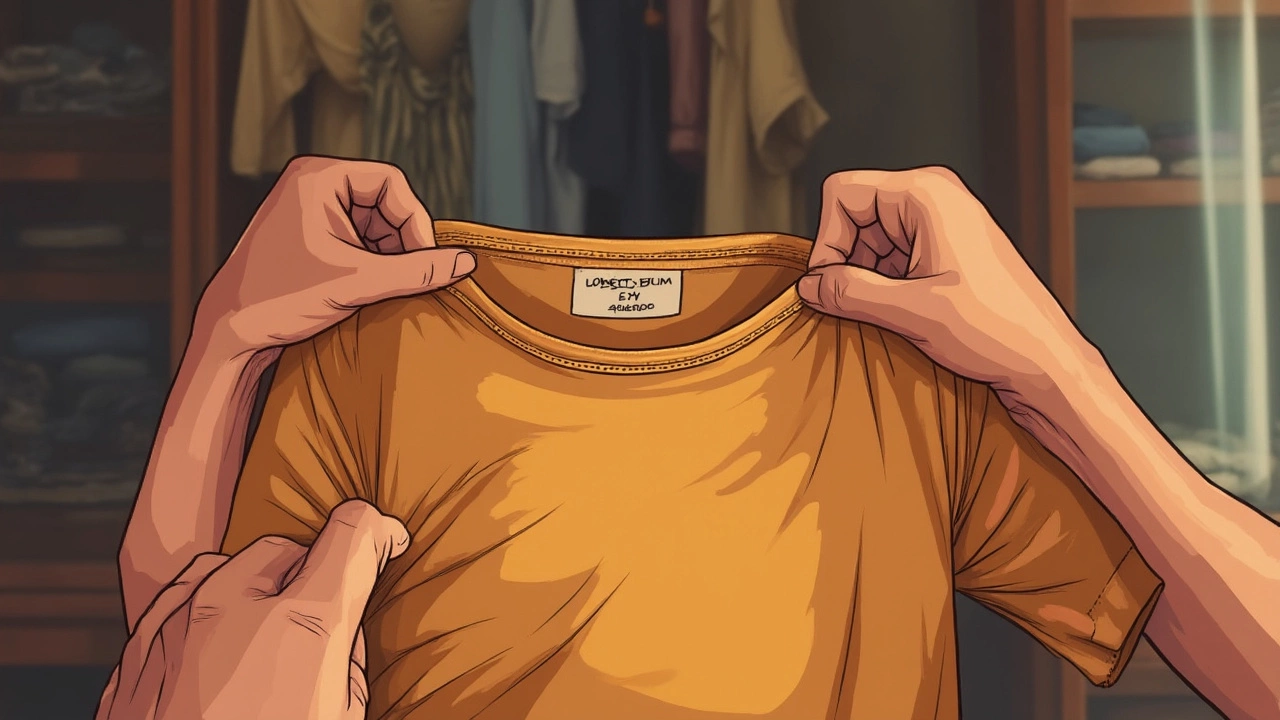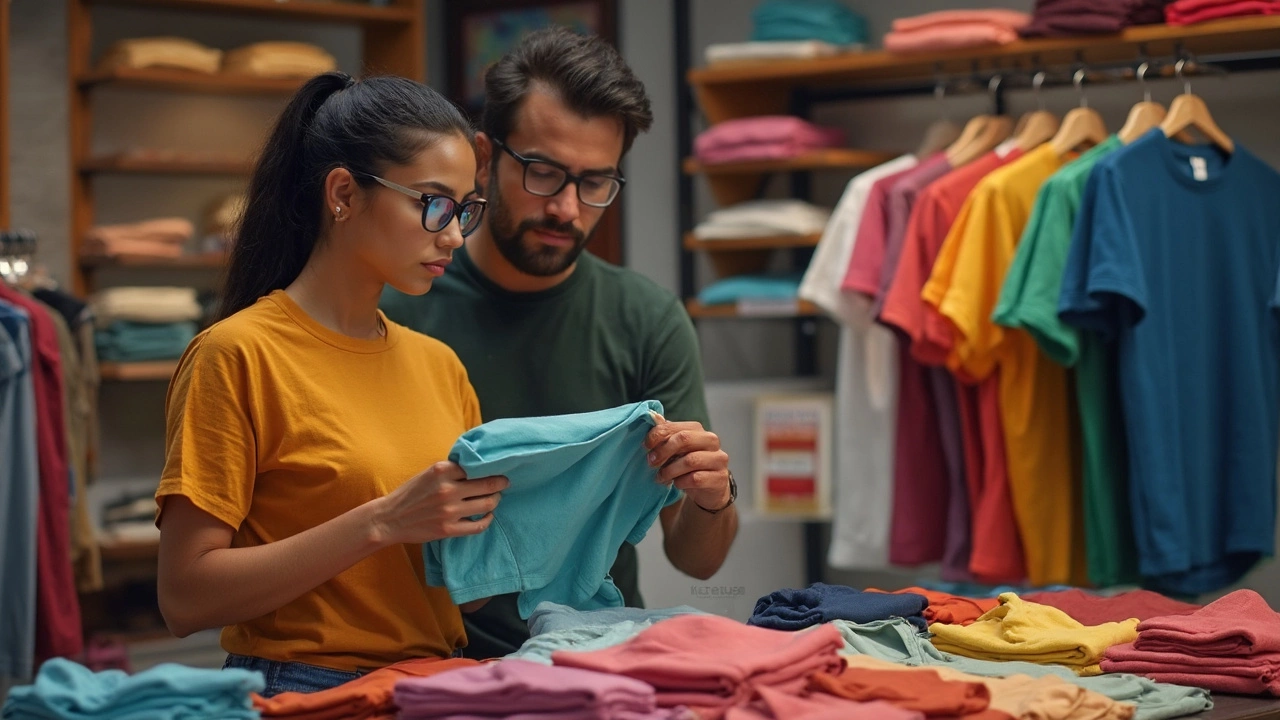Ever picked up a t-shirt that felt great at the store, but after a couple of washes, it turned limp and sad? Yeah, that's the frustration. There’s a real trick to telling which t-shirts are going to last and which will end up as pajamas in a month.
The first thing most people look at is the design or brand, but that's not what keeps a tee looking good down the road. Pay attention to the feel between your fingers—high-quality fabric just feels different. It's not scratchy or overly glossy. If you can, scrunch up a small part of the shirt and release it. Does it bounce back or stay wrinkled? That bounce-back is a fast test for quality cotton that’ll hold up.
- Feel the Fabric: What Really Matters
- Stitching and Seams: Where Quality Shows Up
- Smart Details Most People Ignore
- How T-Shirts Handle Washes and Wear
- Why Price Doesn’t Always Mean Quality
Feel the Fabric: What Really Matters
Start with the basics: always check the fabric first. If a shirt is labeled 100% cotton, that's usually a good sign, but not all cotton is the same. The softer, smoother feel you get from some t-shirts usually means they’re made with long-staple fibers, like Pima or Egyptian cotton. These fibers are stronger and last longer than the regular stuff.
You’ll sometimes see "combed" or "ringspun" cotton. That means the cotton's been specially treated to remove short fibers and make the material smoother and stronger. Ringspun cotton is even softer and more durable than regular cotton—worth paying attention to.
Here’s a trick: Check the shirt’s weight, especially if you shop online. Brands will list something like "180 GSM" (that’s grams per square meter). Heavier isn’t always better, but most plain tees fall in the 140-220 GSM range. Around 180 GSM is usually perfect for a sturdy but wearable tee. Too light? It’ll feel flimsy. Too heavy? It might feel stiff or hot.
If you’re in a store, hold the fabric up to the light. If you can easily see through it, the quality’s probably not great, unless it’s meant to be super-lightweight for hot weather. And run your hand over the surface—look for any roughness or loose bits. That stuff gets worse with every wash.
- 100% cotton feels natural, but blends (like cotton-poly) can help with stretch and resist wrinkles.
- Watch for buzzwords like "Supima." That’s a certified high-quality American-grown cotton, not just a fancy name.
- If a tee feels cold or slippery, it probably has too much polyester.
| Fabric Type | Feel | Pros | Cons |
|---|---|---|---|
| Ringspun Cotton | Very soft, smooth | Durable, comfy | May cost more |
| Combed Cotton | Soft, even | Resists pilling | Usually more expensive |
| 100% Cotton (Regular) | Basic soft | Breathable, cheap | Prone to shrinking |
| Cotton-Poly Blend | Smooth, stretchy | Holds shape well | Can pill faster |
Bottom line? Use your fingers and your eyes before you pay. The high-quality t-shirt doesn’t just look good on day one; it should feel just as solid after a bunch of washes.
Stitching and Seams: Where Quality Shows Up
If you want t-shirts that last, pay close attention to the stitching and seams. This is where shirts either win or lose. A high-quality t-shirt will have even, tight, and straight stitches. Loose threads or uneven stitching? That's a sign the shirt will likely fall apart after a handful of wears and washes.
Flip the shirt inside out. Seriously, brands can hide their worst work inside. Look for these things:
- Double stitching across the shoulders, collar, and hems. It means extra toughness in spots that usually get the most stress.
- No gaps or loose threads along the seams.
- Shoulder seams should be flat and not puckered up—this helps the shirt hold its shape.
- Side seams (when present) should be straight and not twisting around the body.
Chain stitching is another sign of a well-made t-shirt. If you see a pattern that looks like links in a chain, especially around the hem, that’s good news for durability. Flatlock seams are common in athletic and high-end tees—they help prevent chafing and are put together so the inside is just as clean as the outside.
| Stitch Type | Durability | Where You'll See It |
|---|---|---|
| Single Stitch | Low | Basic tees, budget brands |
| Double Stitch | Medium-High | Hems, sleeves, better brands |
| Chain Stitch | High | Vintage, premium tees |
| Flatlock | High | Athletic wear, premium seams |
Here’s a stat worth knowing: According to a 2024 survey from a major fabric trade show, t-shirts with double or chain stitching last up to 35% longer than single-stitched ones. So, next time you shop, don’t just go by how a shirt looks from the front—give those stitches a real checkup. You’ll dodge flimsy tees and get more mileage out of every shirt.

Smart Details Most People Ignore
The small stuff on a t-shirt can tell you more about quality than any label ever could. Most people totally overlook things like collars, tags, hems, and even the way the sleeves are cut. If you want your tee to keep its shape and look sharp after a bunch of washes, you have to check these parts out.
The collar is one of the first places cheap shirts start to sag. A solid, double-stitched collar sits flat and keeps looking good way longer. Run your finger around the neckline—if you notice tight, smooth stitching (with no loose threads), that's a good sign. Floppy collars? Walk away.
Another overlooked spot is the hem, especially at the waist and sleeves. Pro-quality shirts use a "coverstitch" or double-needle seam here. It's much stronger than the basic single stitch. Grab the bottom of the tee and gently tug—does the stitching stretch or start to unravel? Skip anything that feels sketchy.
Tags matter too. More high-quality brands are moving to printed or heat-sealed labels instead of sewn-in fabric tags that itch and poke. No one wants to wear a shirt that scratches your neck all day.
One stat that's wild: a study by Cotton Incorporated found that t-shirts with double-stitched hems were 42% less likely to get stretched out compared to single-stitched versions after 30 washes.
| T-Shirt Detail | What to Look For | Why It Matters |
|---|---|---|
| Collar Stitching | Double-stitch, no loose threads | Prevents sagging, looks sharper longer |
| Hem | Coverstitch or double-needle seam | Resists stretching and fraying |
| Tag | Printed/heat-sealed label | Comfort, no neck irritation |
| Sleeve Set | Smooth, even alignment | Keeps shape with movement |
Check if the design is printed straight across the chest—it shouldn’t wobble or slant (super common with cheaper tees). None of these details take long to spot, but they make a world of difference in how a high-quality t-shirt feels and wears.
How T-Shirts Handle Washes and Wear
You know those t-shirts that somehow shrink, stretch out, or get weirdly thin after a couple of washes? Turns out, it’s not just bad luck—there’s real science behind why some t-shirts hold up way better than others.
The type of cotton matters a lot. For example, long-staple cotton (like Pima or Egyptian) is known for keeping its shape and softness way longer than regular cotton because the fibers are stronger and less likely to break during washing. T-shirts that say "preshrunk" on the label usually shrink less, but honestly, a little bit of shrinkage (about 3-5%) is normal, even for top t-shirts.
Stitching also plays a big part. If you see double stitching along the seams and sleeves, that’s a green flag for durability. Single-row stitching? Prepare for seams that might split when you least expect it. And if the neckband gets stretched out in the first few washes, that’s a clue the construction or fabric wasn’t up to snuff.
Here’s what science and real numbers say about everyday t-shirt life:
| Type of Fabric | Average Lifespan (Washes) | Common Issues Over Time |
|---|---|---|
| Standard Cotton | 30-40 | Fading, minor shrinkage, light pilling |
| Pima/Egyptian Cotton | 50+ | Minimal pilling, holds color better |
| Cotton-Poly Blend | 40-50 | May stretch out, less fading |
| 100% Polyester | 75+ | Rarely shrinks, might pill or snag |
Want your high-quality t-shirt to survive laundry day after day? Follow these tips:
- Wash in cold water to protect fibers and color.
- Flip your shirts inside out—this keeps the surface looking fresh.
- Skip the dryer or use low heat. Hanging t-shirts to dry prevents shrinkage and twisting.
- Use mild detergent, and keep bleach far away unless you love faded tees.
If you spot strong, dense fabric and solid stitching on a high-quality t-shirt, there’s a good chance it’ll stand up to real-life wear and washing. Cheap tees might feel OK at first, but after ten trips through the spin cycle, they start telling the truth about how they’re made.

Why Price Doesn’t Always Mean Quality
Walk into a store and see a $50 t-shirt next to a $10 one, and it’s easy to think the pricier one is better. But cost alone doesn’t tell the whole story. Brands can mark up prices because of hype, logos, or just because people expect to pay more. That has nothing to do with how long the shirt will last or how good it feels after ten washes.
Here’s a thing: Some of the best high-quality t-shirt brands use mid-priced or even cheap materials. On the flip side, smaller brands or lesser-known labels sometimes use way better cotton and build but don’t spend on marketing, so their prices are lower even if the shirt itself rocks.
The real test isn’t the number on the tag—it’s how the shirt is made. Stuff like double-stitched hems, sturdy shoulders, and solid cotton beats a flashy logo every time. It’s pretty common to find expensive t-shirts made with basic single-stitching, even though research shows double-stitching can make a shirt last twice as long. In a 2023 industry survey, 60% of people said brand was their main reason for paying extra, not quality.
| Shirt Price Range | Likely Material | Stitching Quality | Brand Premium |
|---|---|---|---|
| $8-$20 | Basic Cotton/Polyester Blend | Single Stitch | Low |
| $21-$45 | Combed/Vintage Cotton | Double Stitch | Moderate |
| $46+ | Varies (Sometimes Same as Mid-Range) | Mixed (May have single stitch) | High |
Want to know if you’re paying for quality and not hype? Check labels for fabric type, look inside for neatness in stitching, and actually feel the shirt. Don’t fall for price alone. When in doubt, online reviews and fabric breakdowns can tell you a lot more than a price tag or a name you recognize.
